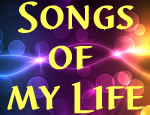
I listened to music whenever I could. The only exception was in the morning when I listened to The Loop with Steve Dahl. The Loop, or Steve Dahl, was that ‘other friend’ we all talked about at school. While I would have to fight to stay up and watch ‘Saturday Night Live’, mornings I could listen to any station I wanted and it was easy to convince Dave. So when I got to school, I would be up to date on Steve Dahl, and his sidekick Gerry Meiers, latest antics to discuss them with my friends.
Listening to The Loop was classic for a teen living in the late seventies; well, a guy, in Chicago or the surrounding suburbs. What I didn’t know was Steve Dahl started in March 1979. This was after he was let go from WDUI (one of the iterations of WLS-FM in the 70’s) who had switched from an AOR format to all disco. Needless to say, Steve Dahl was no fan of dIsco. When he started at The Loop, he started a morning routine of ‘blowing-up’ a disco record on the air. Of course, this was all sound effects but for those of us looking to revolt against the Bee Gees and Donna Summer, it was a call to arms.
My family was very typical. I would say we were a Gallup family but no one ever asked for our opinions. We just ended up liking what most Americans liked. Though we didn’t have many choices as we do now. There were the 3 national tv stations, 6 if you counted WGN, FOX and PBS. We typically watched the most popular show on each. Music – top 40, which in the late ’70s meant disco. When Elvis died the greatest hits 8-track was purchased and we listened to Elvis when there was nothing on the radio. Leisure suits were the new trend so we each had a Leisure suit (anything that did not include a tie).
But as we each got our own cars, jobs and friends, we were breaking out of the Gallup family, at least I was. When Steve Dahl started blowing up Disco records on the air, I was all in. Well, I wasn’t ALL in. I was in enough to buy a Loop shirt and to put Loop stickers on my notebooks – like a lot of other kids. The Loop logo was iconic. Simple black and white letters in a ‘painted’ font.
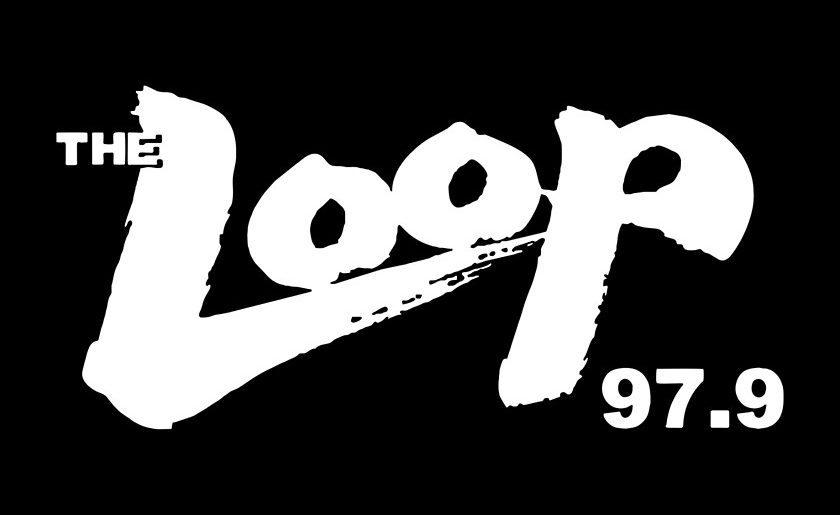 I didn’t know what a font was back then but I did appreciate them without knowing what they were. The geeky/nerdy side of me collected Monster, Starlog and other magazines. I created cardboard boxes to store the magazines in. For the box lids, I carefully traced out the magazines’ titles in two different sized fonts. I thought it looked cool. The bottom line was I thought the Loop logo was cool also. There was a rumor that someone had covered their car completely in Loop stickers. I don’t remember seeing it but it sounded cool too, though possibly a tad bit redneck.
I didn’t know what a font was back then but I did appreciate them without knowing what they were. The geeky/nerdy side of me collected Monster, Starlog and other magazines. I created cardboard boxes to store the magazines in. For the box lids, I carefully traced out the magazines’ titles in two different sized fonts. I thought it looked cool. The bottom line was I thought the Loop logo was cool also. There was a rumor that someone had covered their car completely in Loop stickers. I don’t remember seeing it but it sounded cool too, though possibly a tad bit redneck.
When I say I wasn’t “all in”, I never actually joined Steve Dahl’s Insane Coho Lips club. Steve’s anti-disco army (a clear takeoff of the Kiss Army fan club). While I was a member in spirit, I didn’t want to actually part with $5 – that could have been converted into an album.
Disco really was running out of control. We had already suffered through Saturday Night Fever who brought the Bee Gees up as their glittering warriors. Next to them was the Village People, Donna Summer, Chic, Chaka Khan and Taste of Honey. Even before Ted Nugent, Foreigner and Queen could get through, they would have to battle Barry Manilow, Gino Vannelli and Toto. An army was definitely needed. While Grease seemed to support the troops you really couldn’t tell whose side they were on. Between Travolta and Newton-John, they were just a distraction. We ran them off with the Blue Brothers but they were repulsed with Sgt Peppers Lonely Hearts Club musical. Who’s side was Aerosmith on? Everyone started looking at Queen. Dammit, Freddie! There were really just too many of them. Steve saw this. He was the right man for the job. And he sure hated Disco.
But it wasn’t just Steve Dahl and Gerry Meiers fighting. His army was growing each day. While we talked about his latest disco destructions at school, Steve had also formed a band: Steve Dahl with Garry Meier and Teenage Radiation. They did parodies of current hits. Their first song was a call to arms on the anti-disco front, “Do You Think I’m Disco” over Rod Stewart’s ” Do You Think I’m Sexy” (there were a number of questionable rock ‘n’ roll members who had been flirting with the enemy).
Now we listened in the morning to see what disco album Steve and Gerry would blow-up and catch “Do You Think I’m Disco.” Steve Dahl with Garry Meier and Teenage Radiation actually released their parody as a single peaking at #58 on the Billboard charts. At one time, Steve was out so Gerry Meier played a bunch of their songs that morning. I was able to catch them on a cassette tape. Over the years I lost the tape but recollected the songs from videos on Youtube. Going through the songs was really like a cross between childhood memories and Chicago history lesson:
“Do You Think I’m Disco” (based on Rod Stewart’s “Do You Think I’m Sexy”, a call to arms for the Insane Coho Lips Army)
“Skylab” (based on the Rolling Stones’ “Shattered”, the Spacelab ‘Skyfall’ was to fall and NASA had no idea where is was going to land)
“Oh Wally” (based on Barry Manilow’s “Mandy”, Steve and Gerry would mock Wally Phillips’ radio show, who Aunt Joyce listed to in the morning, and this parody was born)
“Another Kid in the Crawl” (based on Pink Floyd’s “Another Brick in the Wall”, dangerously mocked the John Wayne Gacy murders and we loved it)
“Ayatollah” (based on The Knack’s “My Sharona”, during the Iranian Hostage Crisis, it was so popular it peaked over #20 on the WLS charts so they were even playing it)
“RTA” (based on AC/DC’s “TNT”, mocked the problems of the Chicago public transportation system under Mayor Jane Byrne)
“Falklands” (based on J. Geils Band’s “Freeze Frame”, about the British invasion of the Falkland Islands off the coast of Argentina)
“Crew Cut Hero” (based on Foreigner’s “Juke Box Hero”, about a plumber with a crew cut, yea – it was the end of the classic parodies)
With army recruits joining by the dozens each day, Steve Dahl was ready to strike disco with a fatal blow: Disco Demolition Night. The Loop worked with the Chicago White Sox on a promotion for the doubleheader against the Detroit Tigers. The actual promo was to get into the game for 98¢. The Whites Sox were hoping for an extra 5,000 fans to take advantage of hype Steve Dahl and Gerry Meier was creating around the anti-disco movement. And it was a movement. Other anti-disco event had occurred out west. This was going to top them all.
So on July 12, 1979, it was obvious the promotion was a success. Thousands of fans brought their disco records to the demolition. But it wasn’t just a few thousand, attendance was estimated over 50,000. They really didn’t know how many because fans kept sneaking into the game. The issue was it wasn’t the game they came there to see. Between the games, Steve Dahl was going blow up all the collected disco records. When the moment finally arrived, Steve Dahl was driven around Comiskey Park’s field in an army jeep and wearing his army jacket and helmet to 50,000 and more rock-starved, disco-hating fans. Any doubt he had that no one would show was squashed. It was out of control. The Disco-Haters had already been throwing their extra records or anything else they could find onto the field. While the White Sox lost to the Tigers, no one seemed to have cared.
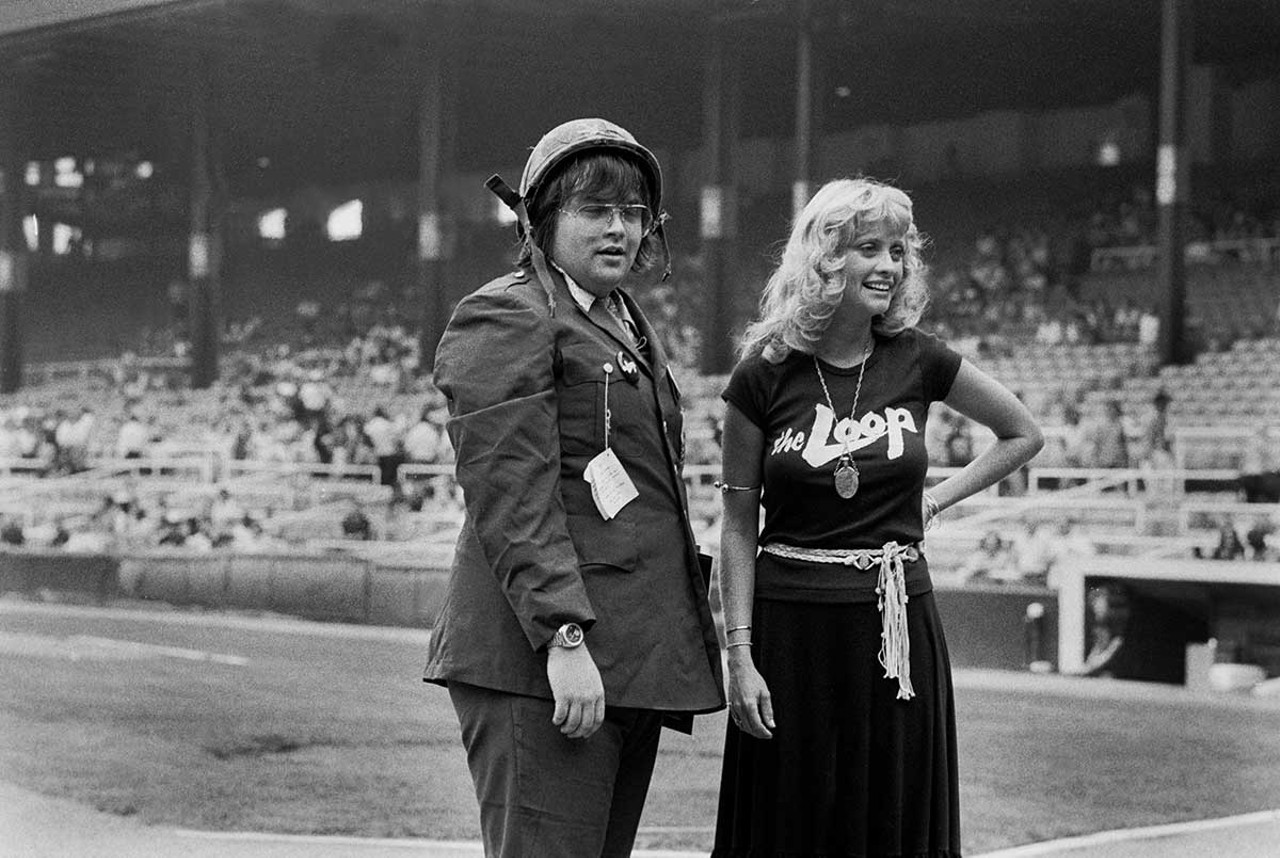 After circling the field, a wet Steve Dahl (he had been blessed a number times by his adoring fans) was brought to the center of the field where the bin of disco records hooked with explosives was set up in the outfield. Steve was surrounded by radio and baseball elites as he addressed his fans. Finally, through his mic, he gave his ‘Leap for Mankind’ pronouncement:
After circling the field, a wet Steve Dahl (he had been blessed a number times by his adoring fans) was brought to the center of the field where the bin of disco records hooked with explosives was set up in the outfield. Steve was surrounded by radio and baseball elites as he addressed his fans. Finally, through his mic, he gave his ‘Leap for Mankind’ pronouncement:
“This is now officially the world’s largest anti-disco rally! Now listen—we took all the disco records you brought tonight, we got ’em in a giant box, and we’re gonna blow ’em up reeal goood.”
OK, it didn’t actually go that smoothly. There was a mixture of Loop and White Sox entourage around Steve at the time. An obviously unchoreographed send-off was given. Eventually, the crowd was treated to some sparks and smoke that headed to a box in front of the Disco Bin. There was a series of smallish explosions until finally, BOOM! Vinyl and smoke were spewed across the outfield.
While security was watching the exits to keep people from getting in, no one was watching the field. And on to the field they came. It was like a dam breaking. First one, then seven, then fifty, a hundred. Estimates on the number of ‘field crashers’ ranged from 2,000 to 7,000. Poor Harry Carey tried to reason with the kids to get off the field – like that would work. The White Sox owner Bill Veeck took the mic after Steve Dahl blew up his records and tried to reason these vagrants but for them, the party was just starting. This is why they had come to Disco Demolition.
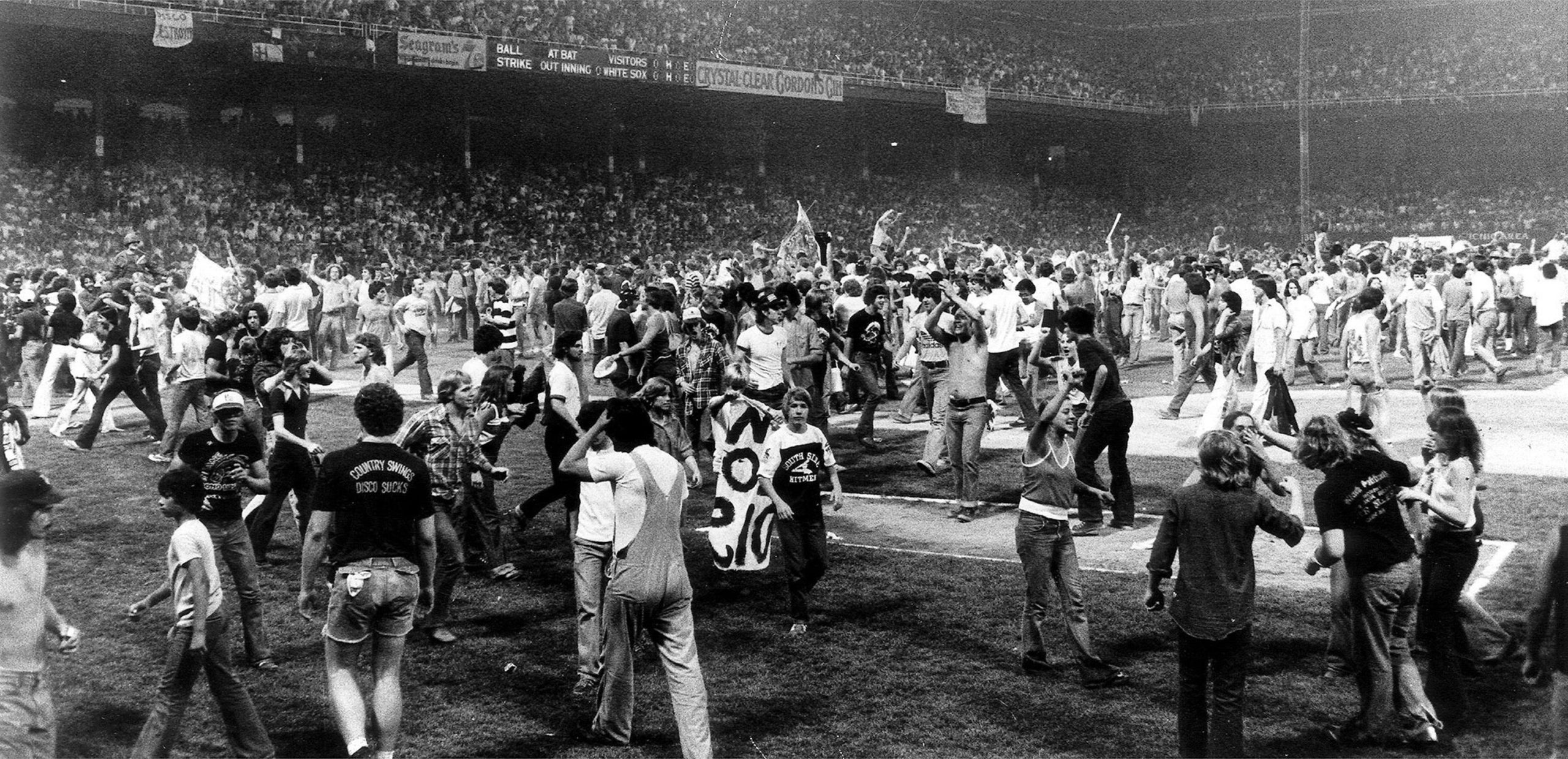 Unfortunately the fans on the field was only part of the White Sox’s problem. It turned out there was now a bit of a crater in center field where the box of Disco records had been. The burning records had seemed to have spread to a batting cage that was pulled onto the field. People were stealing second base – literally. An impromptu ump was calling anti-disco fans safe or out as they slid into home plate. They were dancing on the pitching mound, actually more hopping around on it than dancing.
Unfortunately the fans on the field was only part of the White Sox’s problem. It turned out there was now a bit of a crater in center field where the box of Disco records had been. The burning records had seemed to have spread to a batting cage that was pulled onto the field. People were stealing second base – literally. An impromptu ump was calling anti-disco fans safe or out as they slid into home plate. They were dancing on the pitching mound, actually more hopping around on it than dancing.
Eventually, someone told security to forget about the gates and keeping people out, they had real problems inside. It took the Chicago Riot Police to finally get the field cleared. But the damage had already been done – both physically and metaphorically. The hole in the outfield would need to be repaired and the umpires had decided that the second game of the doubleheader could not be played so the White Sox had to forfeit. Way to go, guys, you screwed it up for everyone.
I had been called into the porch where the TV was by Aunt Joyce and Uncle Jack to see that portion of the news. I was in awe of what had happened. Like Steve Dahl, I didn’t really think much would from the promo. I liked the Disco Demolition theme but wasn’t really into baseball, particularly the White Sox. (I was a Cub fan. If you could claim that by watching ½ or ¾ of a game. I just wasn’t into baseball.) I got the sense that Aunt Joyce and Uncle Jack was trying to point out the follies of Rock ‘n’ Roll. If anything they reinforced it.
The next morning Dave and I had The Loop on as we got ready for school. Steve Dahl and Garry Meier were recapping the events from the night before. Apparently, after Steve blew up the Disco records he made his way back to their seats. “I was getting ready for the next game and then all these people started coming out onto the field,” he said.
It was quite the buzz at school as well but I didn’t know anyone that had actually gone to the game. Or anyone that had actually watched the game on TV. Apparently there were not alot of White Sox fans in Deerfield High School back then. More likely, I didn’t hang out with a bunch of White Sox fans. But if anything was going to put Steve Dahl front and center with high school kids, it was a riot. That’s what they started to call it.
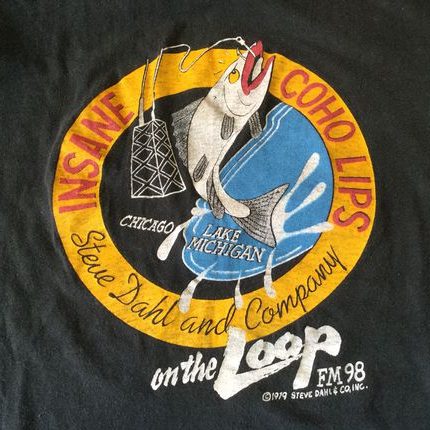 The fact that this was a national news story was exciting but over time there was a seriousness about that actually happened. Now its been forty years since that night. The White Sox actually celebrated the 40th anniversary of Disco Demolition. There has been a number of articles written about how the anti-disco movement was against blacks or gays. I know from my own perspective, I didn’t see Disco as ‘gay music’. I was so far removed from the gay community at the time I didn’t really understand that there were actually gay students in Deerfield High School. Sure there were queers and faggots all over the place but a quarter of them were my friends. I’m sure I was one of them. Racial? I wasn’t into R&B, or Black Music as we called it. I liked Earth, Wind and Fire. I remember buying Michael Jackson’s ‘Off The Wall’ album and hiding it between other albums because I was embarrassed to buy a ‘black album’.
The fact that this was a national news story was exciting but over time there was a seriousness about that actually happened. Now its been forty years since that night. The White Sox actually celebrated the 40th anniversary of Disco Demolition. There has been a number of articles written about how the anti-disco movement was against blacks or gays. I know from my own perspective, I didn’t see Disco as ‘gay music’. I was so far removed from the gay community at the time I didn’t really understand that there were actually gay students in Deerfield High School. Sure there were queers and faggots all over the place but a quarter of them were my friends. I’m sure I was one of them. Racial? I wasn’t into R&B, or Black Music as we called it. I liked Earth, Wind and Fire. I remember buying Michael Jackson’s ‘Off The Wall’ album and hiding it between other albums because I was embarrassed to buy a ‘black album’.
But I never saw Disco as black music. Disco was the Bee Gees and the Village People, and Rod Stewart’s ‘Do You Think I’m Sexy’. To say to be anti-disco to be anti-black wouldn’t have made sense to me. Maybe if you connected the dots I could see that person’s perspective but the anti-disco movement was an anti-popular music movement. My family liked disco, therefore, I was anti-disco. Over time and from what I’ve read, it sounds like people connected the dots for Steve Dahl. At the time, he lost a job due to disco as a music format. It didn’t represent people or a culture. Virtually blowing up disco records was fun and we could all laugh about it and convince ourselves that rock or punk was better music.
As always, some people will ruin it for everyone else. There will be that ‘guy’ who thinks that only gay people like disco or actual racists who front anti-disco to cover their hatred. But that voice can echo and end up in places it shouldn’t be. In minds that don’t understand. So while it starts out all in fun it ended up echoing in darker chambers. I get it. But I didn’t get it when I was in high school.
These stories started from a playlist I made about songs that were important to me. The first song as based on a question: “What is the first ‘pop’ song you remember hearing, and recognized it as a song you hear over and over. So not songs, hymns or your parents’ records but a song you picked out and recognized when it was played on the radio. Where did this music come from?
After Thomas Edison invented the phonograph in 1877, only the rich could really afford this luxury item. It would take almost 50 years for records to crossover to the poor. Why would the poor by a record player when they could buy a radio and get music for free? Sounds a lot like streaming, eh? At first records were for the rich – so it was classical music and jazz. If you throw a singer in front of the orchestra, you have ‘Big Band’. Ken Burns’ Country Music series showed ‘Hillbilly music’ as the opposite end of classical music. ‘Hillbilly music’ gain the attention of record companies as they competed for records sales. It turned out people will basically buy any kind of music.
So this is my perspective on how we got to disco. When Elvis stole the rhythm & blues from black culture, he basically splintered Country music and popularized Rock ‘n’ Rock. R & B is regulated to blacks, whites are split on Rock ‘n’ Roll and Country. Once the money machine is rolling in the US, England joins in with the British Invasion and the Beatles knock out Elvis from the top spot. All this is driven by the youth with business pulling the strings and raking in the dough.
It is important to realize in the 50’s that with the baby boomers, for the first time youth are marketed to. Businesses found that teenagers are great at diverting money from their ampul parents – movies, hangouts, Rock ‘n’ Roll. Youth realized with this market pull comes power. More money, more power – and more awareness. When Vietnam breaks out Youth find their voice. This fractures the family system. Parents are challenged but the disenfranchised Youth are poor. As Youth explores their voice they realize they do not need money to be heard. But some do, and Love is free.
The hippie movement is seen through the Beatles. Both Rock ‘n’ Roll and R & B become experimental. The one-time Beatles-Challengers, The Beach Boys lose their muse with Brian Wilson. But despite the ‘Free Love’ and the poor Youth the bands are making an incredible amount of money. After the Beatles breakup, the money comes rolling in: The Rolling Stones, Led Zepplin, The Who, Crosby, Still & Nash. A few family acts make some significate money: The Osmonds, The Jackson 5.
So now comes my theory: What if the record business made their own groups? or one better yet, their own type of music and sold it to the Youth? This way they would be in front of the artist. It took the excess of Rock ‘n’ Roll and the movement of R&B to put the pieces together. It could have been the beginning of guerilla marketing campaigns when a director took a band showing their new dance moves to back his movie to start a dance movement. One could say it was a failed experiment or the beginning of next-level marketing.
There is no way to say ‘Saturday Night Fever’ was a failure. The movie launched a few careers, The Bee Gees being one of them. Bob Dylan said ‘There’s no success like failure and failure is no success at all’. The manufactured beats were creative and packaged in glamor. Which bore a completely opposite reaction – punk – gritty, real and offensive. Whatever Disco was, Punk was the opposite. And by contrast, the house lights were turned on and the disco ball’s twinkle dimmed. We could see a way out.
So when I was able to hang out with my friends, I wanted to be cool. We thought it was cool not to like current pop music, Disco. So it was an easy move to Steve Dahl’s Disco Demolition. But high school boys are more talk than action, so when it got out of control in Cominsky, everybody wanted things to settle down. Steve Dahl continued to blow up disco records on the air but I think he was starting to look for an exit. Not to leave The Loop but I think he wanted to get out of the anti-disco business. Steve Dahl was a talented morning DJ – he was funny and he got us kids to look at Chicago a different way. We became more aware of what was going on beyond our families, friends and school. He made our world a little bigger and a little more relevant. But it was mostly about the music.
The AOR radio format throws out the 45 vinyl format. AOR – Album Oriented Rock was born out of the FCC killing the simulcast of their the FM stations on their AM station counterparts. The radio stations needed a cheap way to play different music. So they let the DJ’s play whatever they wanted. So they could play folk to hard rock, jazz to gospel as long as there were people listening. The point was they did not have to just play the singles anymore. As this style developed, instead of giving a DJ a box of 45’s to play, there were given a list of songs from albums that they could choose from.
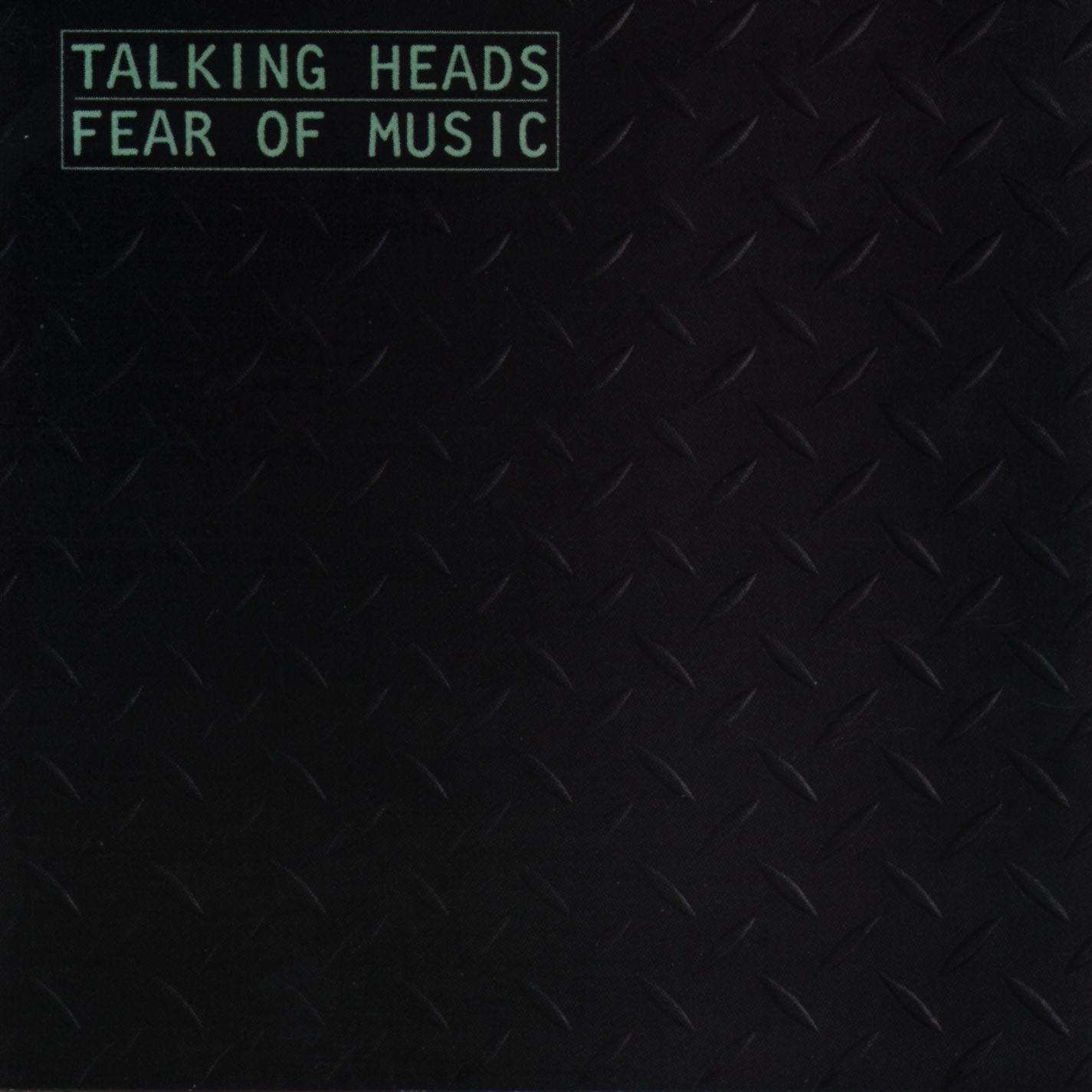 So stations began programming songs that were not just singles. So when ‘Fear of Music’ was released in August of ’79, The Loop immediately started playing ‘Life During Wartime’ and they weren’t alone. Record companies did not always release singles from new albums. Now they were letting the AOR DJ’s find the singles for them. “Life During Wartime” resonated with music fans across the country. So it was selected as their first single off their ‘Fear of Music’ album and released that September. It fit into my covert view of Anti-Disco perfectly.
So stations began programming songs that were not just singles. So when ‘Fear of Music’ was released in August of ’79, The Loop immediately started playing ‘Life During Wartime’ and they weren’t alone. Record companies did not always release singles from new albums. Now they were letting the AOR DJ’s find the singles for them. “Life During Wartime” resonated with music fans across the country. So it was selected as their first single off their ‘Fear of Music’ album and released that September. It fit into my covert view of Anti-Disco perfectly.
But when I first listened to the album I was taken back by how strange it was. Until this point, I had been listening to The Beatles, Blue Oyster Cult and Fleetwood Mac. None of the other songs were like “Life During Wartime” and yet they were. The second single, “I Zimbra” which starts the album was in another language. WTF? The next song “Mind” while in English, did not fall in line with the music I was used to. Prophetically David Byrne was telling me “I need something to change your mind”. I enjoyed the guitar moments but there was all this other ‘stuff’ in the music. “Paper” brought jarring rhythms. “Cities” actually sounded like “Life During Wartimes”, as a remake. After “Life During Wartime” the first side ended with “Memories Can’t Wait” a psychotic trip into the band. It was years before I would try pot but this song gave me the taste of it. I was almost afraid to flip the album over, but I did.
The second side did nothing to persuade me to the Talking Head cause, “Air”, “Animals”, “Electric Guitar” and “Drugs” were all experiments in playing their instruments. The sole exception was “Heaven” which was the most traditional of their songs. Years later “Life During Wartime” would end up consistently on mixed tapes but in one sense they were successful, I was afraid of their music and did not buy their following album “Remain In Light”. It would not be until the college buzz, both figuratively and literally, would have me revisit them with “Speaking In Tongues” and reacquaint myself with “Fear Of Music” and purchase “Remain In Light”. It was hard to change what I was used to listening to then but this challenge would eventually get me to discover that people are like music, if you don’t like someone you may not be listening to them the right way.
Talking Heads’ ‘Fear of Music’ was not an album I would play all the time. It would take years for me to get comfortable with this new music. I was learning how to listen to music. Learning how to take responsibility as a listener. To listen to what was good, even if it didn’t sound like the other songs I knew. It was a lesson I would repeat over and over again. I had spent typically $5 on about an hour worth of music. There were so many people that helped to put these songs together, I owed it to myself to see the best in it. I didn’t have time for dancing, or lovely dovey. There was no party, it was no disco – I was just fooling around.